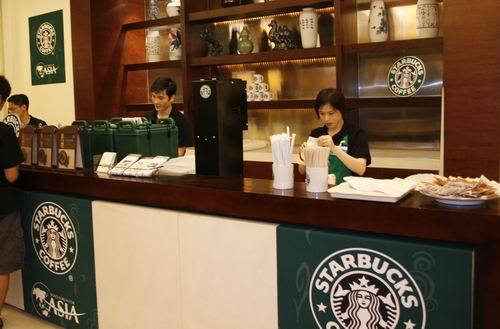Starbucks changed from "cafe" to "restaurant"?
When it comes to Starbucks, coffee must be the first thing that comes to mind. However, at the end of July, Starbucks launched a "fresh Food" project in parts of China, which launched not coffee, but as many as 38 new food products, including spaghetti.
For Starbucks, which has always been obsessed with coffee, the move is undoubtedly subversive. Back then, Starbucks founder Howard Schultz once shouted, "get sandwiches out of Starbucks!" Today, sandwiches appear openly on the counter of Starbucks.
Industry insiders believe that the motivation for Starbucks to increase the proportion of meals is not difficult to understand, that is, to enhance profitability, retention capacity and market competitiveness. At the same time, Starbucks is trying to maintain its tone as a cafe while launching more meals. "it's all about coffee."
38 new food products strive for "stronger sense of existence"
Starbucks is famous all over the world for its focus on coffee and has always believed that "the smell of coffee is the soul of a cafe." Ten years ago, its founder Howard Schultz even flew into a rage because the smell of heated cheese masked the smell of coffee, shouting angrily, "get the sandwich out of Starbucks!"
But now, Starbucks has suddenly made a big move, launching 38 meals in one breath, including sandwiches. It is understood that the new products include beef and potato pie, tomato bacon and butterfly spaghetti, chicken and mushroom pie, green vegetable Panino, chicken Panino, Gouda cheese ham star Meiji, layers of beef baguette, lightning puffs and so on. And several kinds of pastries such as classic crisp cake and almond white chocolate have also been preserved.
The price of the new meal ranges from 15 yuan to 32 yuan. The first batch of markets to be launched include Hubei, Hunan, Shaanxi, Henan and other central and western regions, and will be rolled out in other parts of the country one after another.
Industry insiders believe that Starbucks'"fresh Food" project points to changes in four aspects. The first is the "greater proportion of meals", which can be seen from the number of meals. The second is "a stronger sense of existence", which adopts the way of three-dimensional display to attract the attention of consumers. The third is "more salty products", this time the launch of seven salty foods, which is seen as a tribute to the "Chinese stomach". The fourth is to "look more advanced", from the name to ingredients, recipes and live experience are "much more advanced" than before.
Magnify the marginal effect and prolong the time of staying
Why does Starbucks, which has always focused on making coffee, make so much effort to increase the proportion of meals? According to the analysis of people familiar with the catering industry, it is mainly due to the following three reasons.
The first is to further enhance profitability. Cafes around the world know that meals bring more marginal benefits and more profitability than drinks such as coffee.
The second is to allow consumers to stay longer. Increasing the choice of meals in addition to drinks is not only to magnify the marginal benefits, but also an effective way to allow customers to stay in cafes for longer. Increasing the supply of food not only increases the profitability of coffee shops, but also solves the troubling problem of countless cafes: as soon as it is time for meals, customers leave one after another. This may be exactly what Starbucks wants to see, and a longer stay will increase the chances of communicating with customers.
Another reason is competitive pressure. With the upsurge of boutique coffee, there are more and more competitors in the coffee market, and consumers are becoming more and more picky about the environment and products of cafes. Starbucks is also launching more meals to better capture the market.
How to avoid changing from a "cafe" to a "restaurant"
However, there is a classic paradox in the coffee industry: once you eat more, your coffee brand can easily become synonymous with "low style" in the minds of customers. For this reason, some independent cafes prefer to make less money and insist on not serving meals in order not to downgrade.
So, for Starbucks, in increasing the proportion of food, do you still need to maintain the tone of the cafe? It is not hard to find that the answer is yes, Starbucks obviously does not want to turn itself into a restaurant, on the contrary, "it's all about coffee."
In fact, although there are as many as 38 meals in one breath, almost all meals, like this spaghetti, are treated in the form of "coffee with food", regardless of the size, plate, or way of eating. This can be seen in some details: all meals still do not appear on the formal menu behind the bar, all meals are presented in a beautiful appearance and eaten with knives and forks, and the smell of all meals is controlled so as not to affect the aroma of coffee.
In addition, Starbucks makes coffee cards for special new foods-or they prefer to say that they are specially designed to go with all kinds of coffee. For example, double cheese ham toast and Parker market roasted coffee are full and not greasy, while crispy roasted chicken and mushroom pie is considered the best accompaniment to American or Sumatran coffee.
Starbucks is clearly aware that maintaining tonality and avoiding turning from a cafe into a restaurant is a top priority of this food revolution. Industry insiders commented that Starbucks' change, whether it is food, sense of existence, or more advanced experience, is "all adding points to coffee."
(source: Nanfang Daily reporter: Zhao Xinxing)

Important Notice :
前街咖啡 FrontStreet Coffee has moved to new addredd:
FrontStreet Coffee Address: 315,Donghua East Road,GuangZhou
Tel:020 38364473
- Prev

[coffee] what kind of equipment are used in top cafes abroad?
With the promotion, popularization and development of Specialty coffee in the United States and other markets around the world, the creative market in the United States has also given birth to some new coffee equipment, including pressure swing extraction Espresso coffee machines (La Marzocco, Synesso and Slayer), negative pressure extraction coffee / tea machines (Bkon), semi-automatic siphon coffee /
- Next

There is a coffee shop in Berlin that uses the baking process to promote itself.
In its birthplace, Seattle, Starbucks opened a Starbucks boutique bakery, the world's largest flagship store, at the end of 2014, a store design similar to a factory store that peddles their coffee culture through the baking process. This practice of providing customers with a close contact with the baking process is happening in more and more cafes. Starbucks has announced that in New York and Shanghai
Related
- What ratio of water temperature and ground does the smart cup method use to press coffee? The difference between brewed coffee and filtered coffee?
- What is the standard process for the purpose of coffee cup testing? What is the difference between hand-brewed coffee and cup testing?
- How to use hand-brewed coffee paragon small golden balls? How does cold coffee lock in the aroma of coffee?
- Is American coffee black? What is the difference between American coffee and drip coffee?
- Unexpected! Well-known tea beverage brand Lele Tea will withdraw from the Zhengzhou market!
- Starbucks enters the fashion and beauty industry?! Netizen: Give me an ice American eye cream
- Why can American refills for free? The difference between Americano and American drip pot coffee
- Being chased out of the rain in front of Starbucks?! Store: Sheltering from rain under umbrellas poses a safety hazard
- The white moonlight has changed?! Lucky launches "Big Winter Pear American"
- Hand-brewed coffee three-stage method, high-sweet and universal brewing method to share! What does the high sweet water level of hand-brewed coffee mean?

